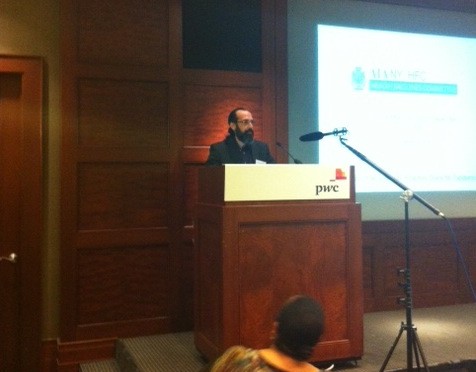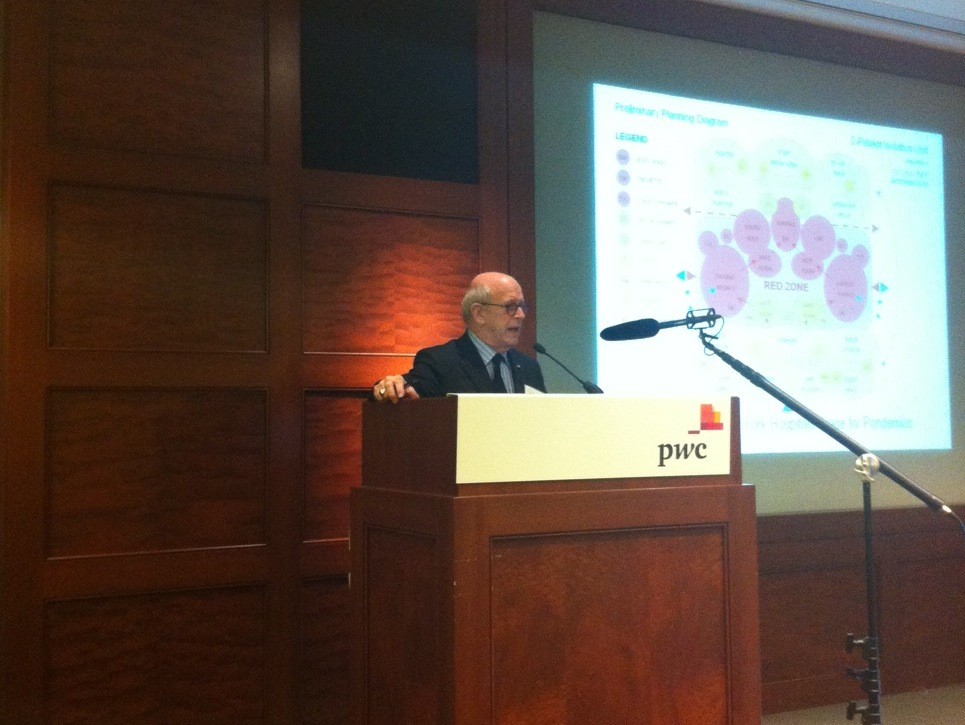by: Bill Millard
Ebola is the most recent form of one of civilization’s deepest fears. From Daniel Defoe’s Journal of the Plague Year and Poe’s Masque of the Red Death, through recent films like Outbreak, 28 Days Later, and Contagion, uncontainable pestilence has consistently gripped people’s imagination, if not always their rationality. The most obvious downside of urban density was once infectious disease. Better public-health infrastructure (chiefly safe water, ventilation, and street and residential sanitation, plus better medical management of microorganisms) was a precondition for what Richard Florida and other urbanists call “the Great Reset”: America’s rediscovery of the many cultural, economic, environmental, and energy advantages of city life. Because urban conditions no longer include rampant tuberculosis, cholera, and the other scourges of the pre-antibiotic era, contemporary New Yorkers can enjoy the benefits of proximity and diversity. Nothing would spoil that particular party like a new and even deadlier plague.
The current epidemic of Ebola virus disease (EVD) ravaging Liberia, Sierra Leone, Guinea, and most recently Mali is larger than previous periodic outbreaks since the virus was first identified in 1976, in part because the virus, normally contained in rural animal reservoirs (fruit bats and nonhuman primates are the leading candidates), has migrated into some of West Africa’s cities. Last month’s joint meeting of medical, civic, and architectural leaders convened by the AIANY Design for Risk and Reconstruction and Health Facilities Committees and the New York Society for Health Planning (NYSHP) investigated contingencies for containing Ebola, should it appear here. Panelists shared knowledge about the disease’s pathophysiology and epidemiologic patterns, along with practical measures in health-facility design to serve two disparate aims: high-level care for infected persons and failsafe isolation procedures to keep staff and civilian populations uninfected.
Ebola is fluid-borne, not airborne, spreading only through contact with a symptomatic person’s body fluids, contaminated objects, or an infected animal. (Bushmeat is a delicacy in some cultures and can be found in certain New York markets, reported Robert Bristow, MD, of New York-Presbyterian Hospital, implying that gazelle steak, cane-rat soup, or other viandes de brousse would be “a food of concern.”) Despite fearmongering in certain media and political realms, Ebola is actually relatively hard to catch. In the U.S., it may have the highest ratio of publicity and attention to statistically realistic risk of any known pathogen. It poses a much less serious threat to citizens than, say, influenza or traffic accidents – yet if it does appear, the precautions against it (which, as the city’s Office of Emergency Management medical specialist Johanna Miele, MPH, noted, are also useful against other infectious threats such as human enterovirus D68) will be well worth the effort.
Along with covering medical workers’ body surfaces with personal protective equipment (PPE), which must be carefully donned and even more carefully doffed after use under the eye of a trained observer (a procedure that takes about a half-hour), design is an essential component of containment, noted Health Facilities Committee Co-chair Jonathan Miller, AIA. Strategies include organizing clinical floors into green, yellow, and red zones (“cool,” “warm,” and “hot,” reflecting contamination likelihood); providing dedicated transport pathways, bathrooms, anterooms, and decontamination showers as well as patient rooms, with negative-pressure ventilation and separate exhaust in the event the spaces are ever used with airborne pathogens; patient rooms with no sharp edges and minimal equipment (cleaning it is difficult, and expensive gear sometimes must be discarded); and careful materials-management flow in and out of a patient unit, particularly handling of medical waste, which becomes voluminous in cases of EVD. Emergency operations plans require exhaustive testing and training; in experiences with the Centers for Disease Control and Prevention’s triage and evaluation algorithms, noted Mark Jarrett, MD, MBA of North Shore-Long Island Jewish (LIJ) Health System, “What we’ve learned is they look very simple; when the staff has a patient, they get very nervous, and this becomes very complicated.”
For a patient who has EVD, New York is actually one of the better places in the world to be. (The best are the nation’s four clinical facilities equipped with high-level biocontainment units: Emory University Hospital in Atlanta, Nebraska Medical Center in Omaha, St. Patrick Hospital in Missoula, and the National Institutes of Health Clinical Center in Bethesda.) In October and November, New York’s medical infrastructure proved capable of handling the single case known to have appeared here; the patient, Médecins Sans Frontières/Doctors Without Borders volunteer Craig Spencer, MD, is a colleague of Bristow, who reported that Spencer’s terrifying experience went as well as could be expected. Dr. Spencer basically did everything right (with the possible exception, from a public-panic perspective, of his already-famous bowling trip): when he noticed symptoms, he went straight to Bellevue, the first of metropolitan New York’s five hospitals currently designated by state and federal authorities as capable of handling EVD (the others are New York-Presbyterian, Mt. Sinai, Montefiore in the Bronx, and North Shore-LIJ). Spencer received superb supportive and advanced care, survived, and passed the mandatory 21-day isolation period, beyond which Ebola survivors are no longer infectious; none of his close contacts, Bristow emphasized, even his girlfriend, has tested positive for the virus. The implications of his case are that the odds against an outbreak here are strong – given the critical combination of well-prepared medical infrastructure and an informed, responsible patient.
Other patients in the future may not be as aware or as careful as Spencer. Hospital personnel – alerted to the importance of patients’ travel history by a less well-handled case, that of the late Thomas Eric Duncan in Dallas – need to prepare to divert infected persons, conceivably more than one at a time, to the appropriate facilities. The North Shore-LIJ system now includes the city’s first dedicated emergency center, located in the Albert Ledner “overbite building” formerly known as St. Vincent’s in the West Village and now known as Lenox Hill HealthPlex, which served as a test case for extensive discussion of plans for a local outbreak. North Shore-LIJ can also quickly set up a “Specialized Disease Treatment Center” by modifying existing space at its Glen Cove hospital (the term “Ebola unit” is avoided not only to minimize stigma, but because it may see other conditions; many such facilities are adapted from existing tuberculosis units). These spaces have dedicated entrances and elevators and can operate without affecting any other clinical services; they also include overnight quarters for staff, who may be reluctant to go home during an outbreak for fear of importing the virus. All of the city’s Ebola-capable hospitals are in communication with each other and prepared to ship patients where capacity is available if any should face high demand. That possibility, up to an all-out pandemic scenario, remains remote – but a remote chance is not a zero chance, and a city cannot afford to relegate it to the imaginations of screenwriters.
Event: Ebola, How New York Hospitals Brace for Pandemics
Location: PriceWaterhouseCoopers Auditorium, 11.18.2014
Speakers: Robert Porr, President, New York Society for Health Planning (NYSHP); Jonathan Miller, AIA, Co-Chair, AIANY Health Facilities Committee, and Lance Jay Brown, FAIA, Co-Chair, AIANY Design For Risk and Reconstruction Committee, and 2014 President, AIANY (introductions); Robert Bristow, MD, Medical Director of Emergency Management, New York Presbyterian Hospital and Director of Disaster Medicine, Columbia University College of Physicians and Surgeons, and faculty member of the National Center for Disaster Preparedness, CU Mailman School of Public Health; Frank Mineo, Ph.D., EMT-P, MPA, FACHE, CEM, Director of Emergency Services, Westchester Medical Center; Johanna Miele, MPH, Health and Medical Specialist, NYC Office of Emergency Management; Marc Jarrett, MD, Senior Vice President, Chief Quality Officer, Eric Cruzen, MD, Medical Director and Chairman of the Emergency Department, and Alex Hellinger, Executive Director, Lenox Hill HealthPlex; Frank Gunther, AIA, Principal, Perkins-Eastman Architects, Designer and Medical Planner, HealthPlex Emergency Center
Organizers: New York Society for Health Planning, AIANY Health Facilities Committee, and AIANY Design for Risk and Reconstruction Committee
Sponsors: United Hospital Fund









